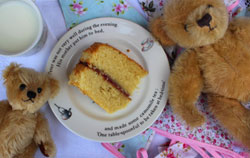 Finding Comfort in Cake
Finding Comfort in Cake
Apparently,
Victoria sponge is one of the new Lockdown number 3 favourites so here you are!
Named in honour of Queen Victoria, Victoria sponge is still a favourite on the royal tea table today. There’s rather a sad story behind it. After Prince Albert died suddenly (he was only 42) Queen Victoria was understandably completely distraught and withdrew to Osborne House on the Isle of Wight where she and Albert had spent several happy holidays.
There she found the new custom of afternoon tea a great comfort: one of her favourite cakes was a plain, light sponge filled with jam. She asked for it so often it became known variously as Victoria sponge, Victoria sandwich, Victoria sponge sandwich or Victoria sponge cake.
From Nursery Tea to Grown-Up Tea Table Thanks to Royal Endorsement
This simple sponge had originally been a popular choice for nursery teas: it was plain and wholesome, yet appealingly soft-textured and sweet. Victoria and Albert had been at the forefront of the brand new nursery concept, encouraging parents to allow their children to enjoy childhood with special games, books and toys.
Prior to this infants progressed more or less directly from babyhood to virtual mini-adulthood. The royal couple had made a point of being present at nursery tea whenever they were home and Victoria must have enjoyed a slice of jam sponge frequently as they played with their brood. In the first throes of her grief she may have sought solace in these happy memories and found the cake consoling as well as easy to digest.
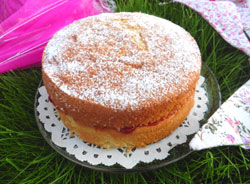
In Victoria’s time, her kitchen maids would have spent hours building up their muscles creaming and mixing the sponge by hand, even after the helpful arrival in Britain of baking powder in 1856. Some cooks still swear by the hand creaming method but it’s much easier (and more reliable for the novice baker) to whip up your sponge by electric means using a food processor, electric mixer or electric hand whisk.
Baking Tips for New Bakers
As with many cooks, this was the first sponge cake I learned to make, and for years now I’ve whipped mine up in a basic food processor using the blade attachment. After a few false starts with self-raising flour I switched to plain and added my own raising agents.
Self-raising flour must be really, really, fresh to work properly and even then I find it touch and go. A combination of cream of tartar and bicarbonate of soda with a ratio of 2:1 works wonders in the well-risen, light and fluffy stakes.
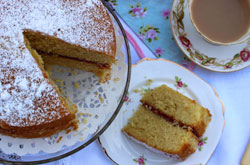
Real butter, slightly salted and softened, the freshest eggs and raspberry jam, ideally seedless, sieved if not, are other essentials. After that, the only variable you have to contend with is your oven, which, ideally, would always runs at consistent temperatures corresponding exactly to the dial and have no hot or cold spots at all.
Alas, many of us are at the mercy of our ovens . . . .
- 175g slightly salted butter, softened
- 175g golden caster sugar
- 175g plain flour
- 1 level teaspoon bicarbonate of soda
- 2 level teaspoons cream of tartar
- 3 medium eggs, as fresh as possible
- 2 tablespoons milk
- Seedless or sieved raspberry jam and icing sugar to finish
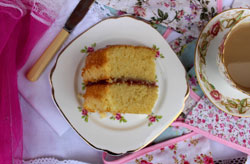
Pre-heat oven to 160C (fan ovens) or equivalent
You will need 2 x greased 18cm (7 inch) loose bottomed sandwich tins
Cream or whiz the butter and sugar until light and fluffy.
Combine the flour and raising agents and sieve half over butter mixture. Add the eggs and the remaining flour. Whisk or whiz again. Add the milk and whisk or whiz until the mixture looks smooth and glossy.
Pour into the prepared tins.
Bake for 18-20 minutes or until risen and golden and a skewer inserted comes out clean.
Allow to rest for a few moments then carefully loosen the edges with a small palette knife.
Transfer to a cooling rack using .a large palette knife to loosen the bottoms.
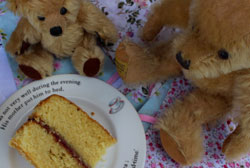
Tip for loosening cakes from the tins
Don’t just whiz quickly round the edge of the cake with your palette knife to loosen it: it’s really easy to slice into the edge of the cake that way and drag away a lot of crumbs!
Instead, go slowing round the edge with the back of the palette knife pressed against the tin and away from the cake.
See also Sugar-Free Sponge for those of you cutting back on sugar. It's made with xylitol, which is actively good for teeth, so an added bonus there.
See also blog with Miss Windsor: Summer Garden Party